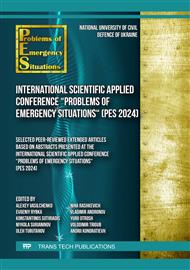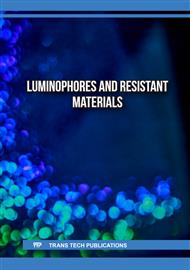[1]
B. Pospelov, V. Andronov, E. Rybka, M. Samoilov, O. Krainiukov, I. Biryukov, T. Butenko, Y. Bezuhla, K. Karpets, E. Kochanov, Development of the Method of Operational Forecasting of Fire in the Premises of Objects Under Real Conditions. Eastern–European Journal of Enterprise Technologies. 2 (2021). 43–50.
DOI: 10.15587/1729-4061.2021.226692
Google Scholar
[2]
I. Medved, Y. Otrosh, A. Kovalov, Y. Mykhailovska, Search for solutions in the problems of calculation of building structures. AIP Conference Proceedings. 2840(1) (2023) 040003.
DOI: 10.1063/5.0168054
Google Scholar
[3]
D. Dubinin, K. Korytchenko, A. Lisnyak, I. Hrytsyna, V. Trigub, Improving the installation for fire extinguishing with finelydispersed water. Eastern–European Journal of Enterprise Technologies. 2/10 (92) (2018) 38–43.
DOI: 10.15587/1729-4061.2018.127865
Google Scholar
[4]
V. Andronov, B. Pospelov, E. Rybka, Increase of accuracy of definition of temperature by sensors of fire alarms in real conditions of fire on objects. Eastern–European Journal of Enterprise Technologies. 4/5 (82) (2016) 38–44.
DOI: 10.15587/1729-4061.2016.75063
Google Scholar
[5]
D. Dubinin, V. Avetisyan, K. Ostapov, S. Shevchenko, S. Hovalenkov, D. Beliuchenko, A. Maksymov, O. Cherkashyn, Investigation of the effect of carbon monoxide on people in case of fire in a building. Sigurnost. 62/4 (2020) 347–357.
DOI: 10.31306/s.62.4.2
Google Scholar
[6]
A. Kovalov, Yu. Otrosh, M. Surianinov, T. Kovalevska, Experimental and computer researches of ferroconcrete floor slabs at high–temperature influences. Materials Science Forum. 968 (2019) MSF 361–367.
DOI: 10.4028/www.scientific.net/msf.968.361
Google Scholar
[7]
B. Pospelov, E. Rybka, R. Meleshchenko, S. Gornostal, S. Shcherbak, Results of experimental research into correlations between hazardous factors of ignition of materials in premises. Eastern–European Journal of Enterprise Technologies. 6/10 (90) (2017) 50–56.
DOI: 10.15587/1729-4061.2017.117789
Google Scholar
[8]
B. Pospelov, V. Andronov, E. Rybka, R. Meleshchenko, P. Borodych, Studying the recurrent diagrams of carbon monoxide concentration at early ignitions in premises. Eastern–European Journal of Enterprise Technologies. 3/9(93) (2018) 34–40.
DOI: 10.15587/1729-4061.2018.133127
Google Scholar
[9]
B. Pospelov, V. Andronov, E. Rybka, V. Popov, O. Semkiv, Development of the method of frequencytemporal representation of fluctuations of gaseous medium parameters at fire. Eastern–European Journal of Enterprise Technologies. 2/10 (92) (2018) 44–49.
DOI: 10.15587/1729-4061.2018.125926
Google Scholar
[10]
A. Kovalov, Y. Otrosh, O. Ostroverkh, O. Hrushovinchuk, O. Savchenko, Fire resistance evaluation of reinforced concrete floors with fire–retardant coating by calculation and experimental method. E3S Web of Conferences. 60 (2018) 00003.
DOI: 10.1051/e3sconf/20186000003
Google Scholar
[11]
A. Kovalov, Y. Otrosh, S. Vedula, O. Danilin, T. Kovalevska, Parameters of fire–retardant coatings of steel constructions under the influence of climatic factors. Naukovyi Visnyk Natsionalnoho Hirnychoho Universytetu. 3 (2019) 46–53.
DOI: 10.29202/nvngu/2019-3/9
Google Scholar
[12]
D. Tregubov, O. Tarakhno, V. Deineka, F. Trehubova, Oscillation and Stepwise of Hydrocarbon Melting Temperatures as a Marker of their Cluster Structure Solid State Phenomena. 334 (2022) 124–130.
DOI: 10.4028/p-3751s3
Google Scholar
[13]
Y. Hapon, D. Tregubov, O. Tarakhno, V. Deineka, Technology оf safe galvanochemical process оf strong platings forming using ternary alloy Materials Science Forum. 1006 (2020) MSF 233–238.
DOI: 10.4028/www.scientific.net/msf.1006.233
Google Scholar
[14]
Y. Hapon, D. Tregubov, E. Slepuzhnikov, V. Lypovyi, Cluster, Structure Control of Coatings by Electrochemical Coprecipitation of Metals to Obtain Target Technological Properties. Solid State Phenomena. 334 (2022) 70–76.
DOI: 10.4028/p-4ws8gz
Google Scholar
[15]
V. Sadkovyi, V. Andronov, O. Semkiv et al., Fire resistance of reinforced concrete and steel structures. Kharkiv: РС ТЕСHNOLOGY СЕNTЕR. (2021) 180. DOI: 10.15587/978–617–7319–43–5
DOI: 10.15587/978-617-7319-43-5
Google Scholar
[16]
D. Dubinin, А. Lisniak, S, Shevchenko, I. Krivoruchko, Yu. Gaponenko, Eksperymental'ne doslidzhennja rozvytku pozhezhi v budivli. Problemy nadzvychajnyh sytuacij. 34 (2021) 110–121. DOI: 10.52363/2524–0226–2021–34–8 2
DOI: 10.52363/2524-0226-2021-34-8
Google Scholar
[17]
M. Zmaha, S. Pozdieiev, Y. Zmaha, O. Nekora, S. Sidnei, Research of the behavioral of the wooden beams with fire protection lining under fire loading. IOP Conference Series: Materials Science and Engineering. 1021/1 (2021) 012031.
DOI: 10.1088/1757-899x/1021/1/012031
Google Scholar
[18]
K. Ostapov et al., Improvement of the installation with an extended barrel of cranked type used for fire extinguishing by gel–forming compositions. Eastern–European Journal of Enterprise Technologies. 100 (2019) 30–36. DOI: 10.15587/1729–4061.2019.174592
DOI: 10.15587/1729-4061.2019.174592
Google Scholar
[19]
H. Xu et al., Experimental study on fire resistance of precast concrete columns with efficient reinforcement. Engineering Structures. 204 (2020) 109947. DOI: 10.1016/j.engstruct. 2019.109947
DOI: 10.1016/j.engstruct.2019.109947
Google Scholar
[20]
Yu. Otrosh, M. Surianinov, O. Holodnov, O. Starova, Experimental and computer researches of ferroconcrete beams at high–temperature influences. Materials Science Forum. 968 (2019) 355–360.
DOI: 10.4028/www.scientific.net/msf.968.355
Google Scholar
[21]
Q. Xu, C. Han, Y.C. Wang, X. Li, L. Chen, Q. Liu, Experimental and numerical investigations of fire resistance of continuous high strength steel reinforced concrete Tbeams. Fire Safety Journal. 78 (2015) 142–154. URL:
DOI: 10.1016/j.firesaf.2015.09.001
Google Scholar
[22]
V.K.R. Kodur, P.P. Bhatt, M.Z. Naser, High temperature properties of fiber reinforced polymers and fire insulation for fire resistance modeling of strengthened concrete structures. Composites Part B: Engineering. 175 (2019) 107104. DOI: 10.1016/j.compositesb. 2019.107104
DOI: 10.1016/j.compositesb.2019.107104
Google Scholar
[23]
Z. Ding et al., Strengthening concrete using phosphate cement–based fiber–reinforced inorganic composites for improved fire resistance, Construction and Building Materials. 212 (2019) 755–764
DOI: 10.1016/j.conbuildmat.2019.04.038
Google Scholar
[24]
Zhenlin Tang, et al., Biomimetic construction of green, fire–proof and super–hydrophobic multifunctionality–integrated coatings via one–step spraying method for steel structures. Colloids and Surfaces A: Physicochemical and Engineering. 683 (2024) 133056
DOI: 10.1016/j.colsurfa.2023.133056
Google Scholar
[25]
A. Vasilchenko, Yu. Otrosh, N. Adamenko, E. Doronin, A. Kovalov, Feature of fire resistance calculation of steel structures with intumescent coating. MATEC Web of Conferences. 230 (2018) 02036.
DOI: 10.1051/matecconf/201823002036
Google Scholar
[26]
K. Ostapov et al., Improving the Quenching of the Undercarriage Space Due to the Adhesive Properties of Gel–Forming Compositions. Key Engineering Materials. 927 (2022) 53–62. DOI:10.4028/p–1su80t
DOI: 10.4028/p-1su80t
Google Scholar
[27]
A. Chernukha et al., Thermodynamic study of fire–protective material. Materials Science Forum. 1038 MSF (2021) 486–491
DOI: 10.4028/www.scientific.net/MSF.1038.486
Google Scholar



